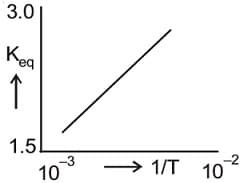Factors Affecting Equilibria
Factors Affecting Equilibria: Overview
This Topic covers sub-topics such as Le Chatelier's Principle, Factors Affecting Equilibrium, Effect of Temperature on Equilibrium, Effect of Inert Gas on Equilibrium, Effect of Catalyst on Equilibrium and, Applications of Le Chatelier's Principle
Important Questions on Factors Affecting Equilibria
Consider the following equilibrium in a closed container
At a fixed temperature, the volume of the reaction container is halved. For this change, which of the following statements holds true regarding the equilibrium constant and degree of dissociation ?
For the chemical reaction , the amount of at equilibrium is affected by –
In which of the following equilibrium, change in the volume of the system does not alter the number of moles –
The exothermic formation of is represented by the reaction
Which of the following will increase the quantity of in an equilibrium mixture of and
At the equilibrium of the reaction, , the number of moles of at equilibrium is affected by the
Which of the following reactions will not get affected on increasing the pressure?
Consider the following reaction in closed container at equilibrium. What would be the effect of addition of on the equilibrium concentration of ?
Which of the following statements are correct for the reaction at
a) .
b) Rate of the forward reaction increases with increasing pressure.
c) Rate of the forward reaction increases on removing gas.
d) Rate of the forward reaction increases with decreasing pressure.
For the following reversible reaction,
Aqueous solution of ferric nitrate when mixed with aqueous solution of potassium thiocyanate gives red colour solution. The intensity of red colour becomes constant on attaining equilibrium.
Choose the correct statement when the following chemical is added to the above solution at equilibrium
() Oxalic acid
() Mercuric chloride
At the equilibrium of the reaction, , the number of moles of at equilibrium is affected by the
What would happen to a reversible dissociation reaction at equilibrium when an inert gas is added while the pressure remains unchanged? Here
The reaction is in equilibrium. Now the reaction mixture is compressed to half the volume
From the following graph represents:

By adding inert gas at a constant volume, which of the following equilibrium will not be affected?
For the equilibrium:
What will be the concentration of , if the equilibrium concentration of is doubled?
In a closed vessel, is heated. is liberated and is left behind. At equilibrium
(i) Addition of , favours forward reaction.
(ii) Addition of , favours backward reaction.
(iii) Increasing pressure favours reverse reaction.
(iv) Increasing temperature favours forward reaction.
Which one of the following is the correct option?
Which of the following statements is incorrect with respect to the given spontaneous reaction?
The ionisation constant of in water is at . The rate constant for the reaction of and to form and at is . If dissociation constant of water at is . If of water at is then the heat of neutralisation is:
Match the following (There may be one or more correct choices)
| Column | Column | ||
| Is unaffected by the inert gas addition | |||
| The forward shift by rise in the pressure and backward shift by the addition of the inert gas at constant pressure | |||
| Is unaffected by the increase in pressure | |||
| The backward shift by rise in pressure and forward shift by inert gas addition at constant pressure |
